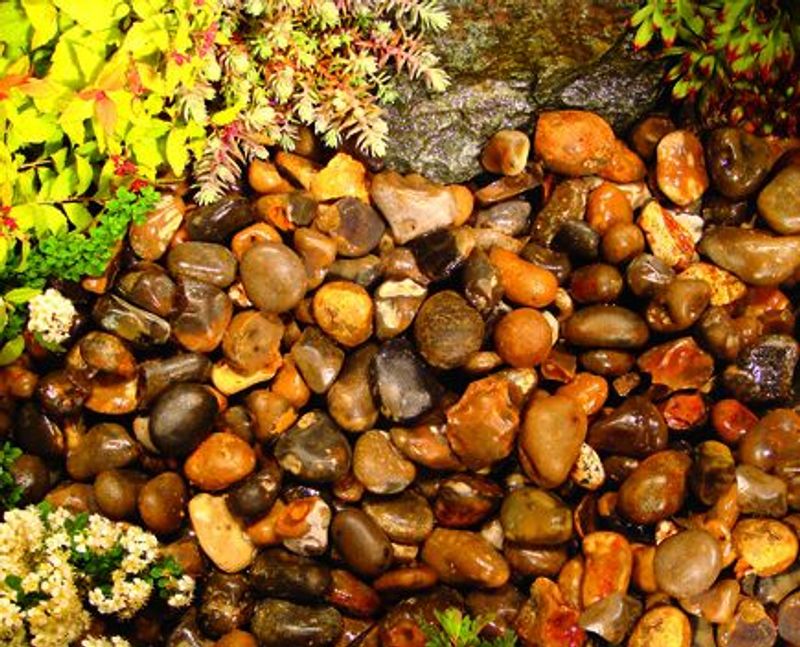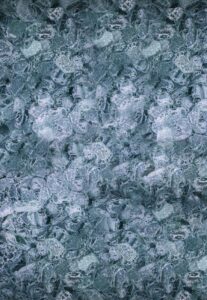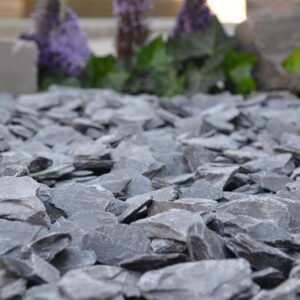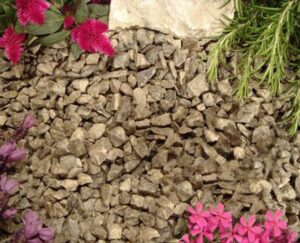Decorative gravel is an ingenious yet simple way of adding a bit of pizzazz to your garden.
So, in case you were wondering ‘should I put gravel around my house?’, the answer is an emphatic yes!
At Drainage Superstore, we’re often asked about the advantages of gravel and pebbles, and why they’re better than grass in many instances.
That’s why we decided to put together a comprehensive guide on the benefits of decorative gravel and why you should consider making a gravel garden.
Let’s get straight to the point.
Table of contents:
- What are the advantages of a gravel garden?
- The best gravel for your garden
- How to make a gravel garden
- Why you should create a gravel garden
What are the advantages of a gravel garden?

Many people think gravel has no place in a contemporary garden, as it’s boring and beige – literally and figuratively.
This is a huge mistake!
In fact, garden gravel designs have made huge strides forward in recent years – so much so, that the latest gravel landscaping ideas are becoming massively popular with the engaged UK homeowner.
Having said that:
Let’s take a closer look at five of the biggest benefits of gravel for gardens.
Affordable
At a time when the cost of living crisis is affecting everyone, any feasible landscaping projects need to be affordable.
The good news is:
Decorative gravel and pebbles are incredibly cost-effective, especially when sourced locally. We’re not saying you should necessarily buy the cheapest available option you can find, as there are other considerations at play.
Also, don’t even think of taking pebbles from your local beach – it’s illegal!
Fun fact – famous writer Ian McEwan was threatened with a £2,000 fine after he admitted to taking a few pebbles from Chesil Beach in Dorset and keeping them on his desk while writing his Booker-prize nominated novella On Chesil Beach in the mid-2000s.
Having said that, we can assure you that even high-quality decorative gravel is relatively inexpensive compared to other landscaping options.
Easy to lay

Garden for gravel is incredibly quick and easy to lay. All you have to do is excavate the area you intend to gravel before laying it and arranging it to your satisfaction. We’ll walk you through the entire process later in this article.
As an added bonus, decorative gravel will largely prevent weed growth.
Low maintenance
Does gravel need maintenance?
Very little!
The thing is:
High-quality gravel and pebbles are virtually maintenance-free. You might have to dust them with a leaf blower every once in a while and get rid of the occasional stubborn weed that somehow managed to make its way through, but that’s about the extent of it!
Simply lay and forget!
Improves drainage
Decorative aggregates allow water to pass through them and find its way into the soil, improving drainage and preventing flooding. This makes them a fantastic solution if your area suffers from long periods of sustained heavy rain.
Versatile & stylish
Decorative gravel is incredibly versatile, coming in a huge variety of colours, shapes and sizes. Whether you’re looking for smaller pebbles or larger cobbles in burnt orange or cool navy, there’s something that’s just right for you! Premium aggregates will definitely add a wow factor to your garden or driveway.
Speaking of which:
What are the advantages of a gravel driveway?
Quite simply, it’s functional, elegant and environmentally friendly! You can even lay a driveway yourself. What’s not to like?
This brings us to the next point, namely:
The best gravel for your garden

Let’s go over the main landscaping gravel types available on the market that you can choose from to create the gravel garden of your dreams.
Pea gravel
Pea gravel is natural gravel which has been smoothed by water and is generally the size of a pea – hence, its name. It comes in a wide variety of colours, with individual stones also having their own unique shades.
Pea gravel is great for pathways and excellent for pipe bedding and drainage. Incredibly versatile, it’s also a really good barrier against weeds. To find out more, check out our step-by-step guide on How to lay a gravel path.
Granite gravel
Granite gravel is sturdy and highly durable. Like pea gravel, it comes in different colours, with black, grey and red among the most popular options out there.
Consider this:
If you have granite worktops in your kitchen, laying granite aggregates in your garden will create a lovely sense of continuity between your interior and exterior design.
Decomposed granite gravel
Usually reddish in colour, decomposed granite is fine and has a rustic look. It’s ideal for use around trees and on pathways. However, we wouldn’t recommend using it close to your house, as your shoes are likely to pick up some of the decomposed granite and carry it inside, making a mess.
Next:
Marble gravel
Marble gravel can add a touch of luxury and sophistication to your garden. Often polished for a smoother finish, marble chippings tend to come in lighter colours like cream. Just don’t use them around plants which require high amounts of acid, as marble affects the pH levels of the soil.
Slate gravel
Last but certainly not least, we’ve got slate gravel. Typically offered in darker hues like black and anthracite grey, slate gravel is ideal for covering large areas in both domestic and commercial gardens. As a result, slate gravel often comes in larger packs of up to 850kg.
How to make a gravel garden

As we mentioned, laying gravel in a garden is a fairly straightforward process. But before you can get to it, you should do a bit of planning first.
Here’s your to-do list:
✅Choose a type of gravel.
✅Decide on an area – ideally, one that gets at least some sunlight.
✅Select suitable edging, such as boulders and rockery stones.
✅Choose suitable plants – allium, cordyline, hypericum and colchicum all work great with gravel for gardens.
Having taken care of the preliminaries, it’s time to get to work.
Here are the steps you should follow:
Step 1: Remove the topsoil
Using a square edge spade, dig your designated area to a depth of approximately 10cm. Once you’ve removed the topsoil layer and any bothersome weeds, smooth the area with a rake and compact it with a tamper.
Step 2: Create a border
Unless you’re planning to lay aggregates over your entire garden, you want to create borders to keep the gravel within its intended location. Metal edging and bricks are all excellent options to clearly mark the outer edges of gravel gardens. Laying stones in the garden is also a good idea.
Step 3: Lay crushed stone
This is an optional step that you could skip. However, adding a 10cm layer of crushed stone across the area and compacting it will provide a much more solid foundation for your gravel garden bed.
Step 4: Lay a weed-resistant membrane
People often ask:
Can you lay gravel on soil?
You certainly can, but we wouldn’t recommend it.
Here’s why:
If left unattended, weeds will eventually start to grow and ruin all your hard landscaping work. And that’s the last thing you want.
So, instead of laying gravel on soil, we recommend laying a weed-resistant membrane between the base and the gravel. While this may seem like an unnecessary expense, you’ll be more than thankful for it in the long run, as a weed membrane will make it even easier for you to maintain your decorative gravel.
Step 5: Lay your gravel
Now comes the fun part!
Spread your gravel on top of the weed membrane at a depth of approximately 3cm and rake it smooth.
That’s all it takes! You’re now ready to enjoy your brand-new gravel garden, plant any drought-tolerant plants, and decorate it further as you see fit.
Let your imagination run wild – the sky’s the limit!
Why you should create a gravel garden

Gravelled gardens are gaining in popularity in the UK as a cost-effective yet incredibly stylish alternative to traditional landscaping.
The thing is:
Decorative gravel and pebbles come with plenty of benefits and little to no drawbacks. And since there are plenty of highly innovative gravel garden ideas floating around, you won’t be short of inspiration.
The bottom line is:
Don’t wait! Transform your garden into a Mediterranean oasis of entertainment and relaxation with a clever application of contemporary decorative gravel.
We promise you won’t regret it.
Want to make sure you have a level surface? Opt for a gravel grid! Find out how to install one via our guide.





















